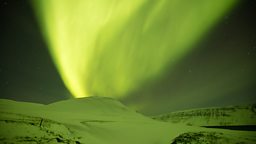Unveiling the Northern Lights
By Russell Barnett, researcher for Wild Scandinavia

If there’s one thing that Scandinavia is known for, it’s the Northern Lights: spellbinding curtains of shimmering greens, purples and reds, dancing in the sky above snow-draped mountains.
When we see the aurora we are witnessing billions upon billions of microscopic explosions
They’re a phenomenon I’ve dreamed of experiencing ever since reading Phillip Pullman’s ‘His Dark Materials’ as a child.
In Scandinavia the Northern Lights, or aurora borealis, have long fascinated the indigenous peoples of the region. Finnish folklore tells of a fox sweeping its flaming tail across the snow, sending ice crystals flying into the sky. To the Sámi people of northern Scandinavia, the lights are associated with the spirits of the dead.
Now, however, we have a better idea of their true origin.
We’ve only had a scientific understanding of what causes the aurora since the beginning of the twentieth century, and even now scientists are continuing to learn more about the exact chain of events that brings about these magical displays. So strap yourselves in; here’s my very simplified explanation.
The different colours come from the various type of gas involved
93 million miles away, the Sun is constantly releasing electrically charged particles, forming a solar wind that heads towards us at incredible speeds.
The Earth’s magnetic field acts as a giant shield against this bombardment. It deflects and accelerates the particles towards the poles where they crash into atoms of gas in our upper atmosphere. Each of these collisions creates a tiny spark of light, so when we see the aurora, we are witnessing billions upon billions of microscopic explosions all at once.
The different colours come from the various type of gas involved, with oxygen producing green or red lights and nitrogen forming purple or blue.

This was my first experience of the aurora, in Iceland’s Westfjords.
it wasn’t the magnificent light show I was hoping for
We were driving just outside a town as the faint glow over the mountain peaks caught our eyes. Pulling over and getting out of the car, we had to squint to check if we were seeing aurora or just clouds. Gradually, the wispy shapes evolved from washed out green-grey to a stronger lime-green colour, confirming what we were seeing.
I’d been told the Northern Lights rarely look as impressive in real life as they do in finished photographs, taken with modern cameras, far more sensitive to light than the human eye. But it wasn’t the magnificent light show I was hoping for.

The next day we travelled by boat to our remote filming location in search of Arctic foxes.
we pulled back the curtains and gawped at what we saw
There was no human infrastructure around us for miles, providing the perfect conditions for aurora watching. Each evening we set alarms to remind us to check the skies outside. After several cloud-covered nights, we pulled back the curtains and gawped at what we saw.
This time, the show was already in full swing. We stepped out into the cold underneath a wide beam of continuous green light, stretching from one horizon right above our heads to the other. Over time this beam split up into several thinner lines that danced in waves like a meandering river.
Witnessing such a strong display of the Northern Lights in such an isolated place was a surprisingly spiritual experience. It’s easy to see how both ancient peoples and modern authors have equated the lights with the supernatural. But for me, it was a great reminder of the hidden beauties of the natural world.

Since the Northern Lights occur in a circular band centred around the magnetic North Pole, it’s easy to work out the best places to see them.
Getting out of the cities and away from light pollution is key to see the lights as clearly as possible
The most famous location in Scandinavia is the coastal town of Tromso, in northern Norway. Here, aurora tourism is an important local industry and countless guided excursions are available. Iceland is also a fantastic and reliable location to see the Northern lights, with tours heading out from the capital, Reykjavik.
But in truth, anywhere in northern Scandinavia offers the potential for aurora and some of the most stunning locations are far off the beaten track. Getting out of the cities and away from light pollution is key to seeing the lights as clearly as possible. It’s also important to pick your timing; clear, cloudless nights between September and March are best.

an unbeatable experience that will always stay with me
Unfortunately, there is never a guarantee of witnessing the Northern Lights, but combining a suitable location with the right time of year and at least 3-5 nights of clear skies should give the best possible chance of success. They may not lead you to a city in the sky like in Pullman’s book, but for me it was an unbeatable experience that will always stay with me.





